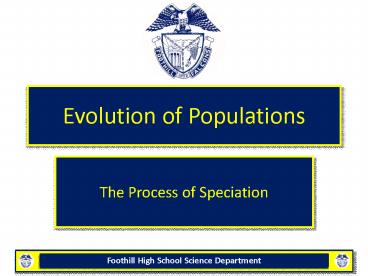Evolution of Populations PowerPoint PPT Presentation
1 / 24
Title: Evolution of Populations
1
Evolution of Populations
- The Process of Speciation
2
The Process of Speciation
- Speciation
- The Formation of New Species
- Species
- A Group of Organisms That Breed With One Another
And Produce Fertile Offspring - Individuals In The Same Species Share A Common
Gene Pool
3
Isolating Mechanisms
- Key Concept
- As New Species Evolve,
- Populations Become More Reproductively Isolated
From Each Other
4
Isolating Mechanisms
- Reproductive Isolation
- When Members Of Two Populations Cannot Interbreed
And Produce Fertile Offspring - The Populations Have Separate Gene Pools
5
Reproductive Isolation
- Can Occur Through
- Behavioral Isolation
- Geographic Isolation
- Temporal Isolation
6
Behavioral Isolation
- Two or More Populations Are Capable of
Interbreeding But Dont Due To - Behavior Differences e.g.
- Different Courtship Rituals
- Other Types of Behavior
- Courtship Songs
- Courtship Behavior
- Sleep/Wake Cycles, etc.
7
Behavioral Isolation
Populations May Share Overlapping Territories
Eastern Meadowlark
Western Meadowlark
Each Species Has Separate Mating Song
8
Geographic Isolation
- Populations Are Separated By Geographic Barriers
e.g. - Rivers
- Mountains
- Bodies of Water
- Deserts
9
Geographic Isolation
- Grand Canyon Squirrels
- Colorado River Formation Of The Grand Canyon
Separated Populations Of Abert Squirrels About
10,000 Years Ago. - Separate species The Kaibab Squirrel Developed
10
Kaibab
Abert
11
Temporal Isolation
- Two Or More Species Reproduce At Separate Times
- Three species of Orchids Each Release Pollen On
Different Days - Frogs in same pond breed in different months
12
Testing Natural Selection In Nature
- Galapagos Finches
- Darwins Radiation Theory Proven By Peter
Rosemary Grant of Princeton University - Required
- Variation
- Beak Size Must Change Fitness
13
Testing Natural Selection In Nature
- Grants Realized Darwins Hypothesis Relied On Two
Testable Assumptions - Inheritable Variation Must Be Present In Current
Population - Variations Must Produce Enough Differences In
Fitness That Natural Selection Will Occur
14
Variation
- On A Single Island The Grants Mapped
- Populations
- Breeding Success
- Wing, Leg, Beak Length
- Beak Depth Color
- Feather Colors
- Bird Mass
- They Verified Genetic Variation
15
Natural Selection
- The Grant's studied finches on Daphne Major,a
small island (800 sq. yd) - In 1977 island had only 2mm of raininstead of
normal 130mm... - The drought resulted in a loss of84 of medium
ground finch population. - Most died of starvation!
16
(No Transcript)
17
Rapid Evolution
- They Were Able To DocumentSeveral Incidences of
Rapid Evolution On Daphne MajorOver Several
Decades
18
Speciation In Darwins Finches
- Key Concept
- Speciation In The Galapagos Finches Occurred By
Founding Of A New Population, Geographic
Isolation, Changes In The New Populations Gene
Pool, Reproductive Isolation, And Ecological
Competition
19
Speciation In Darwins Finches
20
Speciation In Darwins Finches
21
Speciation In Darwins Finches
22
Speciation In Darwins Finches
A B Dont Mate
23
Speciation In Darwins Finches
24
Speciation In Darwins Finches

